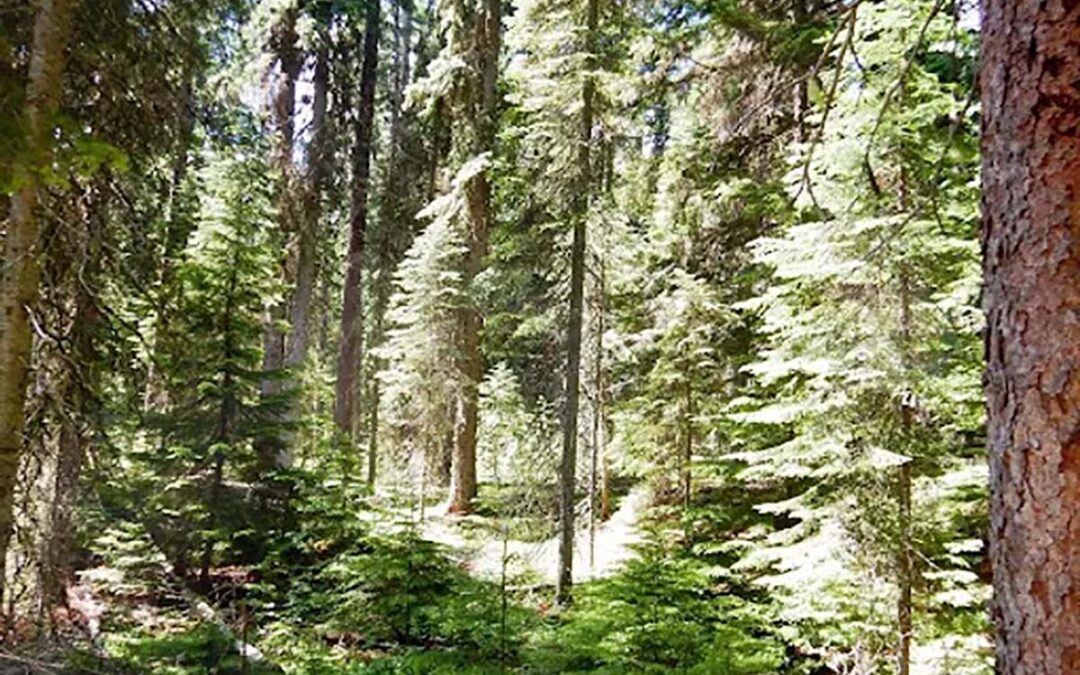Old multistory forest slated for phased clearcut. Logging unit 72, Kootenai National Forest. Photo credit: Yaak Valley Forest Council
By Dominick A. DellaSala, Ph. D, Chief Scientist at Wild Heritage
For four decades, I have been crisscrossing the globe inventorying the irreplaceable ecosystem and climate benefits of older forests from the tropics to the boreal. At the invitation of the Yaak Valley Forest Council last August, I visited the controversial logging Unit 72 within the ‘Black Ram’ project area on the Kootenai National Forest. I was in awe of ancient conifers towering to 150 feet, but alarmed by the Forest Service plan to clearcut more than 3 square miles, including 950 acres of older forest. The agency claimed that the site did not qualify as old growth and needed to be logged for “wildfire resilience” purposes. I beg to differ and here’s why.
The Black Ram project area is an important reference site for assessing and restoring old forest conditions throughout the Kootenai. Once I entered Unit 72, I immediately observed centuries-old cedar, hemlock, spruce, and larch all growing on the same site. Large standing dead trees (snags) were being worked over by grub-eating woodpeckers and decaying logs were functioning as “nurseries” for seedlings growing on the bark surface. In other words, this was no “ordinary” forest that could be sacrificed for short-term gain but was a vibrant old-growth ecosystem, the most resilient forest remaining on the Kootenai.
Older forests like on the Kootenai absorb massive amounts of atmospheric carbon that is stored in large trees, productive soils, and dense vegetation, helping to keep the planet from overheating further. The wetter, shady north-facing slopes of Unit 72 are like outdoor air conditioning for wildlife seeking protection from an overheated, logged-over landscape. During my visit, a heat dome was camped over the region, but it was some 15 degrees cooler in the forest, shaded by massive conifers. Older forests also tend to burn in lower fire severities, and are more capable of withstanding insect outbreaks because of abundant insect-eating bats, birds, and small mammals.
As to resilience, most people know what that looks like in life. Simply put, it’s the ability to bounce back from a calamity. In the case of ecosystems, the more complex the web-of-life, the greater the genetic adaptations for rebounding quickly when naturally disturbed. The few remaining older forests have been adapting to natural disturbances since time immemorial and are the very definition of resilience, needing absolutely nothing from the Forest Service other than restraint. Logging on the Kootenai discombobulates food webs leaving fewer species and diminished gene pools to adapt, which runs counter to resilience. Much of the Kootenai’s forests have been converted to wildfire and insect-prone plantations, easily viewed on Google Earth imagery as a swiss-cheese-like arrangement of clearcuts strewn across the landscape.
Recognizing the importance of older forests to the climate, President Joe Biden on Earth Day 2022 stated, “our forests are our planet’s lungs,” in directing federal agencies to inventory them for conservation purposes. More recently the Forest Service and Bureau of Land Management (BLM) announced proposed rulemaking to develop conservation policies. As the public process unfolds, it is important that the Forest Service act in good faith by withdrawing the Black Ram timber sale along with some two-dozen old forest timber sales nationwide because logging them would be a clear-cut violation of the president’s intent.
The Black Ram Project unfortunately is among some 50 million acres of older federal forests that have no formal protection but are critical to climate policy. Protecting them from logging would also comply with the White House’s “roadmap for nature-based solutions” announced at the November international climate summit to help slow accelerating climate chaos and the planetary biodiversity crisis.
The Forest Service needs to avoid making the Black Ram timber sale a poster-child for what’s wrong with the agency’s approach to resilience and climate adaptation. Pulling the sale now would restore public trust while allowing the agency to comply with the president’s directive to conserve older forests for myriad climate and ecosystem benefits.
Dominick A. DellaSala, Ph. D, Chief Scientist at Wild Heritage, is an award-winning scientist with over 300 peer-reviewed publications and 8 books, including Temperate and Boreal Rainforests of the World: Ecology & Conservation.
(Note from Executive Director Mike Garrity: The Alliance is currently suing to stop the Black Ram logging project. You can support this effort by making a donation here.)
